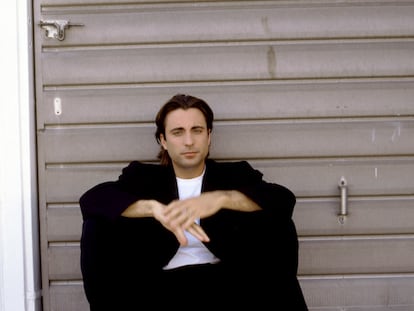Cinecittà is once again the Hollywood set in Europe
Once at risk of disappearing, the Italian studio is running at full throttle thanks to large-scale public funding and the arrival of platforms such as Netflix and Amazon. Roland Emmerich, Angelina Jolie, Luca Guadagnino, and Nanni Moretti have all come to Rome to film their new projects
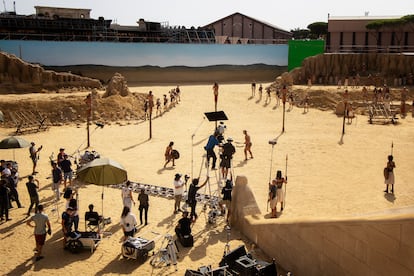
Studio 5 at Cinecittà is firing on all cylinders. In its day, it was Federico Fellini’s favorite, in which he filmed La Dolce Vita, Amarcord and Eight and a Half. The director’s association with the studio was so strong that a funeral chapel was built on the lot for his memorial service in 1993. This summer, a filmmaker of a different nature, Roland Emmerich, left behind his usual disaster films and used the lot to shoot the sword and sandal series Those About to Die, starring Anthony Hopkins as the Roman emperor Vespasian. The set is dominated by an arena in which the gladiators will fight to the death and an imperial box covered in purple fabric, the color of Roman rulers, along with solid marble stands — fake, of course, a convincing illusion made of papier-mâché.
The series, which can be seen on Amazon Prime throughout Europe, is not the only project filmed at Cinecittà in recent months. After almost closing for good just a decade ago, the famous Roman studio complex seems to be experiencing a reversal of fortune. Angelina Jolie has completed filming Without Blood, an adaptation of Alessandro Baricco’s book of the same title. Luca Guadagnino also chose Cinecittà for his two new projects: Queer, with Daniel Craig, and Challengers, with Zendaya. The German Edward Berger, the wunderkind who brought us All Quiet on the Western Front, has just directed Conclave, a papal thriller with Ralph Fiennes. Also at Cinecittà, British director Joe Wright has put the finishing touch to his television adaptation of M: Son of the Century, Antonio Scurati’s novel about Mussolini’s youth. A modern version of The Decameron for Netflix and Ripley, a new take on Patricia Highsmith’s character starring Andrew Scott (the “hot priest” from Fleabag), complete a full-on filming schedule at the location.
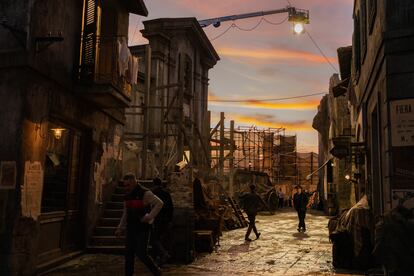
At the end of August and with Rome still deserted, Europe’s largest studio, extending over 60 hectares on the southeastern edge of the Italian capital, was full again. Cinecittà is a miniature city, with countless filming spaces, offices, makeup rooms, props departments, and digital laboratories spread across rationalist buildings basking in the shadows of pine trees. Their walls are painted in a shade of orange that is friendly but not loud, and the decor recalls bygone times, with discarded props from past film shoots scattered here and there. The studio was created by Mussolini in 1937, when Il Duce wanted film production to be at the service of fascist propaganda: according to the slogan of the time, films were “the strongest weapon.”
The history of Cinecittà, like that of 20th century Italy, is a contrast of light and shadow. In its heyday, Ben-Hur, Quo Vadis, and Cleopatra were filmed there, but so were countless cheap historical epics, the so-called sandaloni. There were plenty of classics by auteurs like Visconti and Da Sica, but also patriotic films about the Ethiopian campaign. Extremes meet in Cinecittà: Nanni Moretti filmed part of the recently released A Brighter Tomorrow here, years after rebuilding the Sistine Chapel for We have a Pope, a short distance away from the studio that the Italian Big Brother permanently occupies.
In just over two years, Cinecittà has gone from registering a 30% occupancy rate on its sets in March 2021 to approaching 80%. Since 2021, it has hosted 50 productions, surpassing the Pinewood studios in London, the preferred European location of production giants such as Disney. The studio has also overtaken Babelsberg, on the outskirts of Berlin, which, after a few years of glory, during which it hosted Quentin Tarantino and Wes Anderson, now faces an uncertain future after being purchased by an American investment fund.
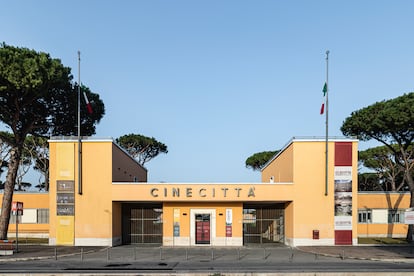
It is not the first time that Cinecittà has risen from the ashes. In 1943, the studios were bombed by the Allied army, before becoming the favorite filming location for Italian neorealism in the first post-war period. And then in the so-called “Hollywood on the Tiber,” when the biggest stars on the planet, from Ava Gardner to Kirk Douglas, walked along the Via Veneto to the delight of the paparazzi (a profession that surely would not exist without Cinecittà). In the eighties, in the midst of the transformation of the film industry, it was on the brink of closure.
It would happen again in 2012, when staff layoffs and the construction of a hotel next to the studio as well as an amusement park in the south of Rome were being considered. Cinecittà World was inaugurated in 2014 with sets by Dante Ferretti, who worked with Pasolini, Fellini, and Scorsese. Those in charge of the studio consider its conversion into a luxury resort dead and buried. “You come to Cinecittà to work and not to sleep,” they say. The only concession to tourism has been the creation of a museum that traces the exciting history of the lots, which Fellini once compared to “the cosmic void before the Big Bang” — the place where, as if by magic, everything could come from nothing.
Rome is now back in Hollywood’s good graces. “The city has never gone out of fashion. What was not always there were its services,” argues Nicola Maccanico, CEO of Cinecittà studios. “The fascination with the history of Cinecittà and Rome are added bonuses, but only if one knows how to offer the right working conditions,” he adds. Maccanico also admits the importance of new clients such as Netflix, Amazon, and the television subsidiary of Sky, although he denies any dependence on making series. “If in 2022 they accounted for 70% of our filming, compared to 30% from films, this year those percentages have been reversed,” he says.
There are other valid explanations to explain this rebirth. In 2021, the Italian Government approved a 40% tax deduction for foreign productions and decided to invest part of the European recovery funds, about €300 million ($3.2 million), in modernizing facilities and building new ones. Since then, Cinecittà has piloted an upgrade of the 19 existing studios and plans to create five more in the coming years. By 2026, its production capacity will have increased by 60%. Three of these sets are external, such as one that recreates ancient Rome, built for an HBO series in 2006, an optical illusion that is difficult not to confuse with the ruins of the city center. Fremantle, an audiovisual content giant in Europe, has signed an agreement to occupy six of Cinecittà's studios permanently for five years. “Pinewood and Babelsberg have excellent facilities, and we work with them a lot, but Cinecittà has the added advantage of the Italian tax credit, which is one of the best on the continent,” says Andrea Scrosati, CEO of Fremantle in Europe. “In addition, Italy offers a unique variety of locations if you have to shoot outdoors.”
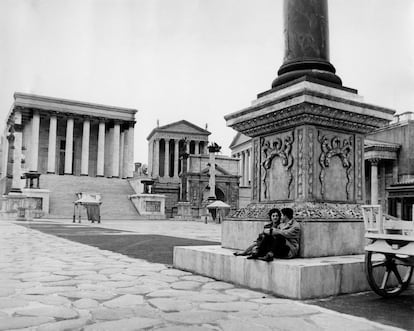
The light that bathes the Cinecittà site also benefits the studios. “Many filmmakers have told me that they wanted to film here to rediscover that intense, warm light of the films of the past,” confirms Maccanico. Photos from the filming of Joe Wright’s miniseries about Mussolini are reminiscent of the chiaroscuro of Once Upon a Time in America or Gangs of New York, to name just two of the hundreds of movies filmed here, ranging from Roman Holiday to Gladiator.
A few months ago, director Saverio Costanzo — responsible for the television adaptation of Elena Ferrante’s My Brilliant Friend — wanted to shoot his new film, Finally Dawn, in the studio. “Cinecittà is not just a film studio, it has a unique and inimitable atmosphere,” Costanzo says. “Cinecittà is us.”
Sign up for our weekly newsletter to get more English-language news coverage from EL PAÍS USA Edition
Tu suscripción se está usando en otro dispositivo
¿Quieres añadir otro usuario a tu suscripción?
Si continúas leyendo en este dispositivo, no se podrá leer en el otro.
FlechaTu suscripción se está usando en otro dispositivo y solo puedes acceder a EL PAÍS desde un dispositivo a la vez.
Si quieres compartir tu cuenta, cambia tu suscripción a la modalidad Premium, así podrás añadir otro usuario. Cada uno accederá con su propia cuenta de email, lo que os permitirá personalizar vuestra experiencia en EL PAÍS.
¿Tienes una suscripción de empresa? Accede aquí para contratar más cuentas.
En el caso de no saber quién está usando tu cuenta, te recomendamos cambiar tu contraseña aquí.
Si decides continuar compartiendo tu cuenta, este mensaje se mostrará en tu dispositivo y en el de la otra persona que está usando tu cuenta de forma indefinida, afectando a tu experiencia de lectura. Puedes consultar aquí los términos y condiciones de la suscripción digital.
More information
Archived In
Últimas noticias
Alain Aspect, Nobel laureate in physics: ‘Einstein was so smart that he would have had to recognize quantum entanglement’
Imelda Castro, the woman who wants to rule the cartel battleground of Sinaloa
The new victims of the Republican war on Obamacare: Millions hit by soaring health insurance premiums
A country divided on migrant rights: Some US states expand protections while others restrict them
Most viewed
- David King, chemist: ‘There are scientists studying how to cool the planet; nobody should stop these experiments from happening’
- Reinhard Genzel, Nobel laureate in physics: ‘One-minute videos will never give you the truth’
- Oona Chaplin: ‘I told James Cameron that I was living in a treehouse and starting a permaculture project with a friend’
- Sinaloa Cartel war is taking its toll on Los Chapitos
- Mexico completes its trade shift with the entry into force of tariffs on China and countries without trade agreements


